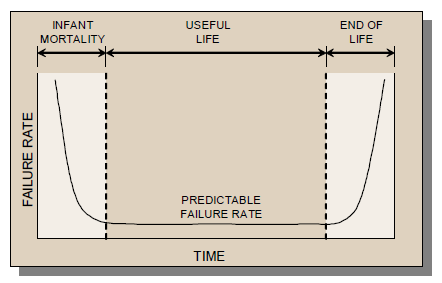 |
| ||||||
Battery Reliability
Reliability, Failure rate and MTBFEach cell in today's VRLA batteries can have a reliability of 0.995, or 99.5% over its useful lifetime, which could be for example 10 years. Reliability simply means; probability for the unit to be functional without faults over a specified time. If the reliability is 1.0 then the unit will work for the whole specified time with absolute certainty.
Failure rate is the probability for the unit to have a fault within a specified time; 
For electronic components and whole systems, such as a small DC/DC converter or a complete UPS,
the term MTBF is more commonly used to describe reliability. MTBF is NOT the expected life time. It is the Mean Time Between Failure during its useful lifetime. Assuming the UPS have a useful lifetime of 20 years, in average one will fail each year if you would have 17 UPS:s.
The reliability (R) over a 10 year period (t) of a UPS with a MTBF of 17 years is;
While the likelihood of that one particular cell will survive its whole useful life is 99.5%,
since a battery string may comprise 200 cells in series, the reliability of a whole battery string is only
0.995^200 = 0.37, or 37%.
Despite the fact that the MTBF of each individual VRLA cell can be calculated as;
Paralleling cells with electronic componentsAssuming one would like to connect some electronic device, such as voltmeter, equalizer etc., to each cell in a battery, and thereby making the reliability of the cell dependent of the connected device, and that this new device has a specified MTBF of 10 years;
The reliability over a 10 year period for each device is; e^(-10/MTBF) = 0.37.
This means that the chance for a device to survive for 10 years is 37%. In this example, the MTBF of each connected device is the same as the MTBF of a whole battery string with 200 cells. The reliability, or the probability, for a battery string to work without failure for 10 years, will be determined by a number of connected electronic devices as followed.
Conclusion
References
|